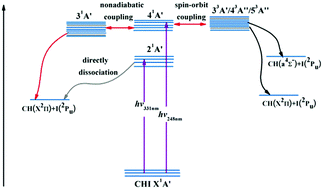Exploring the structure and photodissociation mechanism of the electronic states of iodocarbene, CHI: a theoretical contribution†
Abstract
We present herein a high-level ab initio study on the mono-iodine substituted carbene, CHI, using internally contracted multireference configuration interaction (icMRCI-F12) with Davidson correction which employs wave functions that explicitly depend on the electron–electron distance. The spin–orbit coupling (SOC) effect was included in our calculations. A total of 20 spin-free states with vertical transition energy up to 7.4 eV, as well as 50 spin-coupled states generated from the spin-free states via the SOC were studied. The results show significant influence of the SOC on the bond angles and the harmonic vibrational frequencies of the bending mode of the ground state (X1A′) and the lowest triplet state (a3A′′). Potential energy curves along the bond angle and the bond lengths of the electronic excited states of CHI were investigated. Based on our calculations, photodissociation dynamics in the ultraviolet region was disscussed for the first time, which would pave the way to further experimental investigations of CHI.



 Please wait while we load your content...
Please wait while we load your content...